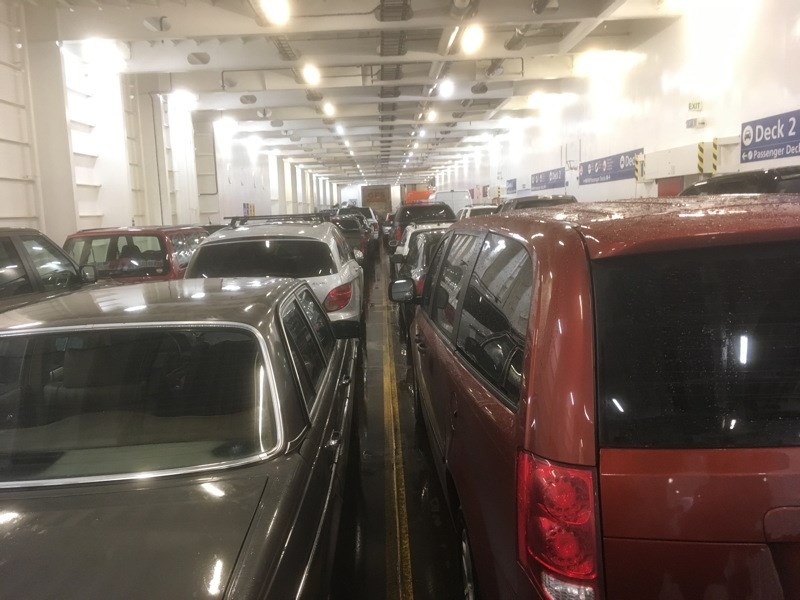 Even before she had a baby, Alannah Bueckert preferred to spend ferry crossings in her vehicle.
Even before she had a baby, Alannah Bueckert preferred to spend ferry crossings in her vehicle.
“Being down below keeps motion sickness at bay. I don’t get seasick if I stay in my car.”
After Bueckert’s son was born, she really didn’t want to budge from her vehicle during voyages, not when he was sleeping, anyway.
So, the Victoria woman wasn’t happy when someone on Wednesday’s 9 a.m. sailing to Tsawwassen told her she had to pack her one-year-old into his stroller and go up top.
Except here’s the deal: It probably wasn’t a B.C. Ferries employee who gave the order. More likely it was an over-enthusiastic fellow passenger misinterpreting the new car-deck rules that took effect on the fleet’s larger ships yesterday.
Bueckert was parked on the upper car deck. You’re allowed to stay in your vehicle there. The new restrictions ban passengers only from vehicles on the lower deck, the one fully enclosed at both ends.
Confused or not, we’ll have to get used to the prohibition. It’s being done in the name of safety, Transport Canada pushing B.C. Ferries to abide by Canada Shipping Act regulations that have been on the books since — no, this is not a typo — 2001.
The ferry corporation had felt other measures kept it within the spirit of the law, but the feds disagreed. (Note that other ferry services don’t allow passengers on closed decks; the Coho to Port Angeles hasn’t done so for 15 years.)
For the most part, passengers were (reluctantly) accepting of the ban on Wednesday. A quick lap around the enclosed deck of the Coastal Celebration found it as devoid of life as Oak Bay after dark.
There was muttering, though. Victorians, wary of change at the best of times (we’re still coming to grips with 2008’s shift to 10-digit telephone dialing), couldn’t see the need for the course correction.
The ban might have flowed from a horrible tragedy (the 1994 sinking of a Baltic Sea ferry in which 850 died), and the 2006 loss of the Queen of the North might still resonate, but B.C. Ferries has had few serious incidents on its main Vancouver Island-Lower Mainland routes. (Three people died when the Russian freighter Sergey Yesenin knifed into the Queen of Victoria in Active Pass in 1970. Twenty-three passengers on a Royal Sealink catamaran were hurt in a collision with the Queen of Saanich in fog off Active Pass in February 1992. One month later, two dozen suffered mostly minor injuries when the Queen of Alberni and a Japanese coal carrier came together in fog off Tsawwassen.)
Many passengers feel they have good reason to stay below decks: sleeping babies, crying babies, a reluctance to leave dogs that will shred the back seat if left alone. People with medical conditions want the peace and quiet. People with limited mobility don’t need the hassle of moving.
Also remember this: In 2003, a Times Colonist story touched on the car-deck carnality that occasionally turned the Queen of Whatever into the Love Boat: “One deckhand spotted an older man making love to a younger woman in his car. When the deckhand tried to tell them their behaviour was not appropriate, the older man replied: ‘Go away. This doesn’t happen to me very often.’ ” Such opportunities will be denied if you’re banished to the Pacific Buffet (we hope).
B.C. Ferries says ticket agents will try to accommodate those with a need to stay in their cars, sending them to the upper deck when requested, if possible.
The logistics of that will be challenging, though. To ensure cars go to the upper deck, they’ll have to be tucked in the reservations line — easyish when there’s a light load, but not when it’s busy.
If staying in your car is really important, best to make a reservation (or, if you have the time, wait for another sailing).
Some drivers will have no choice but to abandon their vehicles. Truckers who like to nap before tackling the Coquihalla won’t be able to do so; semis won’t fit on the low-ceilinged upper deck. Ditto for most campers and RVs.
One other side-effect: With more people flushed out of their cars, the passenger areas will be more crowded. It was still possible to find somewhere to sit on the Coastal Celebration on Wednesday, even with a full load, but passengers who are used to using bags and books to create a buffer in the seats beside them might find that kind of space-hogging no longer possible.
B.C. Ferries staff handed out literature to explain the changes Wednesday, and had extra managers sail some routes to help ease the transition. (Give the corporation credit: For a monopoly, it puts a lot of effort into customer relations. When it was swamped with foot passengers on Thanksgiving, it erected tents, hired musicians to play the lineup, and handed out hot drinks and rain ponchos.)
The literature might ease the confusion, but it still won’t make some people happy.



